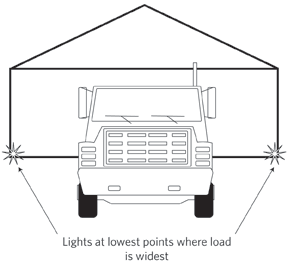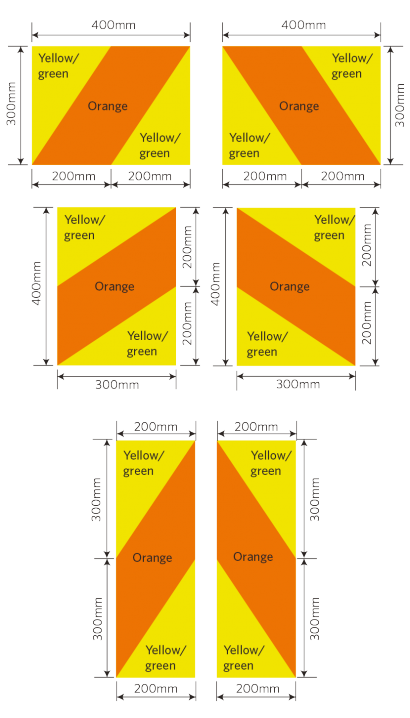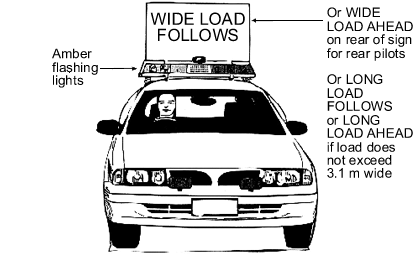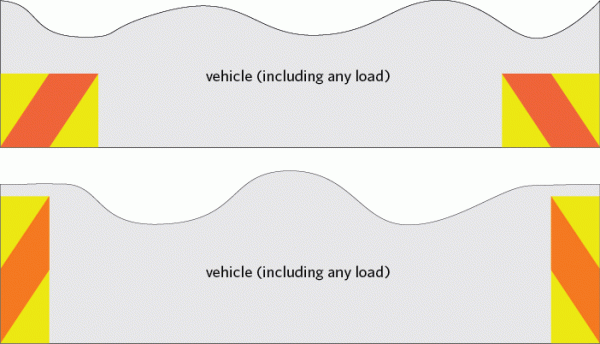If you want to drive an overdimension vehicle along a certain route, you should be sure your vehicle can fit along the proposed route before starting out. Drive along the route in daylight in a standard-sized vehicle first, checking for places where the overdimension vehicle may find it difficult to pass.
If you intend to carry a high load, look out for overhead wires, signs, lights, trees, bridges and tunnels.
An overdimension vehicle must not interfere with or damage any traffic control device, bridge, tunnel or other structure (including wires, cables, banners or any other lawful construction). It must not damage trees or other foliage without the permission of the owner.
If a traffic sign has to be moved so the vehicle can safely pass, the sign must be correctly replaced immediately afterwards. The operator of the overdimension vehicle is responsible for any damage.
An overdimension vehicle must be operated with due consideration for other road users. Other road users must be allowed to pass the vehicle at the earliest safe opportunity.
When travelling during daylight hours, overdimension vehicles must have their headlights on low beam.
Overdimension vehicles must display an amber beacon when travelling on road if they’re more than 3.7 metres wide.
Overdimension vehicles must display an amber beacon if they’re being piloted by a pilot vehicle.
When travelling during the hours of darkness, all overdimension vehicles must be clearly visible (in clear weather) from at least 200 metres away.
Overdimension vehicles, except a standard motor vehicle carrying a load up to 2.7m wide that is not overlength, must display an amber beacon.
If a load is being carried, except for a standard motor vehicle carrying a load up to 2.7 metres wide that is not overlength, there must be steady white or amber lights at the front and steady red or amber lights at the rear. These lights must have an area of at least 50 square centimetres and be positioned so approaching traffic can determine the size of the load and safely get past it. If the load overhangs the deck of the vehicle sideways, these lights must be spaced approximately 1 metre apart across the lowest part of the load and at the widest parts of the load.

Overdimension vehicles, except a standard motor vehicle carrying a load up to 2.7 metres wide that is not overlength, must have side marker lamps spaced approximately 3 metres apart – amber colour to the front and red to the rear.
An overdimension vehicle must not travel on a road if fog, heavy rain, hail or other factors restrict visibility to less than 350 metres. If visibility reduces to less than 350 metres after the journey starts, the vehicle must stop clear of moving traffic as soon as possible, and stay there until visibility improves (ie, more than 350 metres).
The operator of an overdimension vehicle must notify local emergency service personnel in any area where the vehicle or its load is likely to restrict a route in a way that would significantly delay emergency services.
You should check the Waka Kotahi website for up-to-date road conditions and route restrictions for all motorists.
Check current traffic conditions
In addition to these general restrictions, an overdimension vehicle must:
use a route designated by a road controlling authority as suitable for overdimension vehicles, where available, and
comply with the specific route restrictions listed below and any other route restrictions that apply to the route the vehicle takes.
Some road controlling authorities have bylaws that restrict the use of some roads by overdimension vehicles. Contact us or your local council for more information.
Maximum height 4.8m. A vehicle exceeding 3.1m in width must contact the Traffic Operations Centre and may travel on this route provided it is accompanied by a Class 1 Pilot Vehicle as authorised by the Traffic Operations Centre.
No travel on Auckland motorways if the width exceeds 3.1m or the height exceeds 4.3m except for the following:
State Highway 1 between Ramarama Interchange (Ararimu Road Underpass) and the southern end of the Auckland Southern Motorway:
may be used by vehicles that exceed 3.1m in width but are less than 4.8m in height, and
may be used by vehicles that exceed 4.8m in height, if permission is first obtained from Waka Kotahi.
State Highway 18 between the intersection with State Highway 16 and the Old Albany Highway:
may be used by vehicles that exceed 3.1m in width but are less than 4.8m in height, and
may be used by vehicles that exceed 4.8m in height, if permission is first obtained from Waka Kotahi.
Auckland Northern Motorway between the Silverdale interchange and the northern end of the Northern Motorway:
may be used by vehicles that exceed 3.1m in width but are less than 4.8m in height, and
may be used by vehicles that exceed 4.8m in height, if permission is first obtained from Waka Kotahi.
Maximum height 4.8m, maximum width 3.7m. However, an overdimension motor vehicle exceeding these dimensions may travel on the Wellington Motorway provided it complies with Waka Kotahi conditions.
Maximum height 4.27m, maximum width 2.6m, towing vehicle and semi-trailer maximum length 23m, 2m maximum for load overhanging front or rear of vehicle. However, overdimension vehicles exceeding the above maximums may travel if the following conditions are met:
the operator of the overdimension vehicle must obtain permission from Waka Kotahi (through Tunnel Control), and
the operator of the overdimension vehicle must comply with any piloting or travel time restrictions required by Tunnel Control.
Loads that exceed 3.1m width or 4.3m height are not permitted to travel on any toll route unless Waka Kotahi has provided explicit authority to do so. The operator of the overdimension vehicle must comply with any piloting or travel time restrictions required by Waka Kotahi.
If your vehicle or load exceeds 4.3 metres in height, you must comply with these conditions.
| Height (m) | Operating conditions |
|---|---|
|
Greater than 4.3 – up to and including 5 |
|
|
Greater than 5 – up to and including 6.5 |
|
|
Greater than 6.5 |
|
* Apply for an overdimension permit online, or contact the Overdimension Permit Issuing Agency (OPIA) on 0800 OVERSIZE (0800 683 774) or fax (06 953 6313).
The operator is responsible for making sure there are enough pilots to manage the excess height. This will depend on what traffic management(if any) is needed to get around overhead obstructions.
Find out more about load pilots
The operator of a vehicle that is more than 25 metres long has to get written permission from the rail service operator if the vehicle is going to travel over a level crossing.
If the overdimension vehicle is transporting a load more than 30 metres in length, it has to have a rear steering facility.
If an overdimension vehicle has an operated steering jinker or a pole trailer, the rear overhang is measured between the centre of the rear turntable load support and the rearmost part of the load.
If the vehicle combination includes a load-sharing trailer, the load-sharing trailer does not have to be included in forward-distance calculations if the forward distance is 3.5 metres or less. If the forward distance exceeds 3.5 metres, this distance must be added to the forward distance of the main trailer, less 3.5 metres.
If the vehicle combination includes an operated steering jinker, the forward distance used for determining the overdimension operating requirements is half the distance between the two turntables supporting the load.
The operating requirements set out here are minimum requirements. Regardless of the size of the vehicle, the operator of an overdimension vehicle must ensure the vehicle can safely complete its journey.
In particular, this will require adequate clearance along the route, and the vehicle being able to safely share the road network with other vehicles. The operator must ensure pilot vehicles accompany the vehicle in any areas where it is necessary to provide adequate warning and traffic management to approaching traffic.
Find out more about overdimension vehicle categories
These requirements are in addition to the general operating requirements outlined above.
Fluorescent yellow flags (at least 400mm long and 300mm wide) must be attached to indicate the:
excess width of the vehicle or load at its front and rear
front of the load (if it has excess front overhang)
rear of the load (if it has excess rear overhang)
rear of the load (if it has excess length).
You may use retro-reflective hazard panels coloured yellow-green with an orange diagonal stripe instead of flags.
If you’re travelling during the hours of darkness, the flags must be replaced with retro-reflective yellow-green hazard panels with an orange diagonal stripe.
The panels must:
comply with AS/NZ 1906.1: 2007 Retro reflective materials and devices for road traffic control purposes, Part 1: Retro reflective materials
consist of retro-reflective material coloured yellow-green with either a 200mm- or 300mm-wide diagonal orange stripe
have the illustrated dimensions and orientation
be frangible (breakable or readily deformable) if any part of the hazard warning panel extends beyond the body of the vehicle or the load, whichever it is attached to.
If the vehicle is more than 3.1 metres wide, Oversize signs must be displayed at the front and rear.

If the vehicle is more than 3.1 metres wide, Oversize signs must be displayed at the front and rear.

You must not display OVERSIZE signs unless required to do so by the Vehicle Dimensions and Mass Rule.
Read the Vehicle Dimensions and Mass Rule 2016
If the width of the vehicle or load exceeds 3.1 metres and the vehicle travels during the hours of darkness, the overdimension vehicle must be piloted by at least one Waka Kotahi-approved Class 2 pilot.
If the width of the vehicle or load exceeds 3.1 metres and the vehicle travels at a speed over 40km/h, the overdimension vehicle must be piloted by at least one Waka Kotahi-approved Class 2 pilot.
For a convoy of up to three agricultural motor vehicles that are travelling in company and all have dimensions within Category 1, it is sufficient to have one pilot vehicle at the front of the convoy and one pilot vehicle at the rear of the convoy.

Category 1 overdimension vehicles must not travel:
between 0700 hours and 0900 hours, or 1600 hours and 1800 hours, on Monday to Friday inclusive, in any city* area
between 1000 hours and 1300 hours, or 1600 hours and 1900 hours, on Saturday or Sunday
at times when there are unusually heavy traffic volumes.
|
* Note: City is defined as the urban areas of Auckland (between Albany and Drury), Christchurch, Dunedin, Hamilton, Hastings, Invercargill, Napier, Nelson, New Plymouth, Palmerston North, Tauranga, Whanganui, Wellington (including all areas south of Mackays Crossing on State Highway 1 and Te Mārua on State Highway 2) and Whangārei. |
The restricted travel times don’t apply to a motor vehicle whose dimensions, although exceeding the maximum dimensions allowed for a standard vehicle, don’t project outside the lane in which the vehicle is travelling, and the vehicle (including its load) has been certified (under Transport Agency approval) as meeting the road space requirements of a maximum size standard vehicle.
The restricted travel times also do not apply to vehicles designed to be operated in connection directly with the operation or management of a farm.
Please note that travel time restrictions do not apply to a motor vehicle that is being used in an emergency if the operator of the vehicle can provide evidence that the vehicle was required by:
a road controlling authority to repair, or restore access to, a road, railway or bridge
a territorial authority, or a public utility provider, to restore a public utility service
the New Zealand Police to attend an incident or accident
a territorial or local authority to stabilise land or otherwise reduce an imminent risk to persons or property
the Controller, or any member of the New Zealand Police, or any person acting under their authority, to carry out emergency response work during a state of emergency declared under the Civil Defence Emergency Management Act 2002.
These requirements are in addition to the general operating requirements outlined above.
Hazard warning panels must be attached to indicate the:
excess width on each side of an overwidth load or vehicle at its front and rear
front of a load with excess front overhang
rear of a load with excess rear overhang
rear of a load for excess length.
The panels must:
comply with AS/NZ 1906.1:2007 Retro reflective materials and devices for road traffic control purposes, Part 1: Retro reflective materials
consist of retro-reflective material coloured yellow-green with either a 200mm- or 300mm-wide diagonal orange stripe
have the illustrated dimensions and orientation
be frangible (breakable or readily deformable) if any part of the hazard warning panel extends beyond the body of the vehicle or the load, whichever it is attached to.
You must not display hazard warning panels on a Category 2 vehicle unless you’re required to by the Vehicle Dimensions and Mass Rule.


If the vehicle is over 3.1 metres wide, OVERSIZE signs must be displayed at the front and rear.

You must not display OVERSIZE signs unless required to do so by the Vehicle Dimensions and Mass Rule.
Most Category 2 vehicles or loads must have at least one Class 2 pilot.
For a convoy of up to three agricultural motor vehicles that are travelling in company and all have dimensions within Category 2, it is sufficient to have one pilot vehicle at the front of the convoy and one pilot vehicle at the rear of the convoy.

Category 2 overdimension vehicles must not travel:
between 0700 hours and 0900 hours, or 1600 hours and 1800 hours, on Monday to Friday inclusive, in any city* area at times when there are unusually heavy traffic volumes
between 1000 hours and 1300 hours, or 1600 hours and 1900 hours, on Saturday or Sunday
between 23 December and 3 January inclusive
on a national holiday, or after 1600 hours on the day preceding a national public holiday
on a Saturday, if that day is 25 April
in any province on its provincial anniversary holiday, or after 1600 hours on the day preceding that anniversary holiday
at times when there are unusually heavy traffic volumes.
The restricted travel times are relaxed to those of Category 1 if the vehicle (including its load) has been verified (under Transport Agency approval) as meeting the road performance requirements equivalent to a Category 1 vehicle. A Category 1 vehicle that is designed to be operated in connection directly with the operation or management of a farm does not need to be verified, so long as it operates within its own lane.
The restricted travel times also do not apply to vehicles designed to be operated in connection directly with the operation or management of a farm.
Please note that travel time restrictions do not apply to a motor vehicle that is being used in an emergency if the operator of the vehicle can provide evidence that the vehicle was required by:
a road controlling authority to repair, or restore access to, a road, railway or bridge
a territorial authority, or a public utility provider, to restore a public utility service
the New Zealand Police to attend an incident or accident a territorial or local authority to stabilise land or
otherwise reduce an imminent risk to persons or property the Controller, or any member of the New Zealand Police, or any person acting under their authority, to carry out emergency response work during a state of emergency declared under the Civil Defence Emergency Management Act 2002.
|
* Note: City is defined as the urban areas of Auckland (between Albany and Drury), Christchurch, Dunedin, Hamilton, Hastings, Invercargill, Napier, Nelson, New Plymouth, Palmerston North, Tauranga, Whanganui, Wellington (including all areas south of Mackays Crossing on State Highway 1 and Te Mārua on State Highway 2) and Whangārei.. |
Download Factsheet 53a: Overdimension vehicles and loads [PDF, 1 MB]